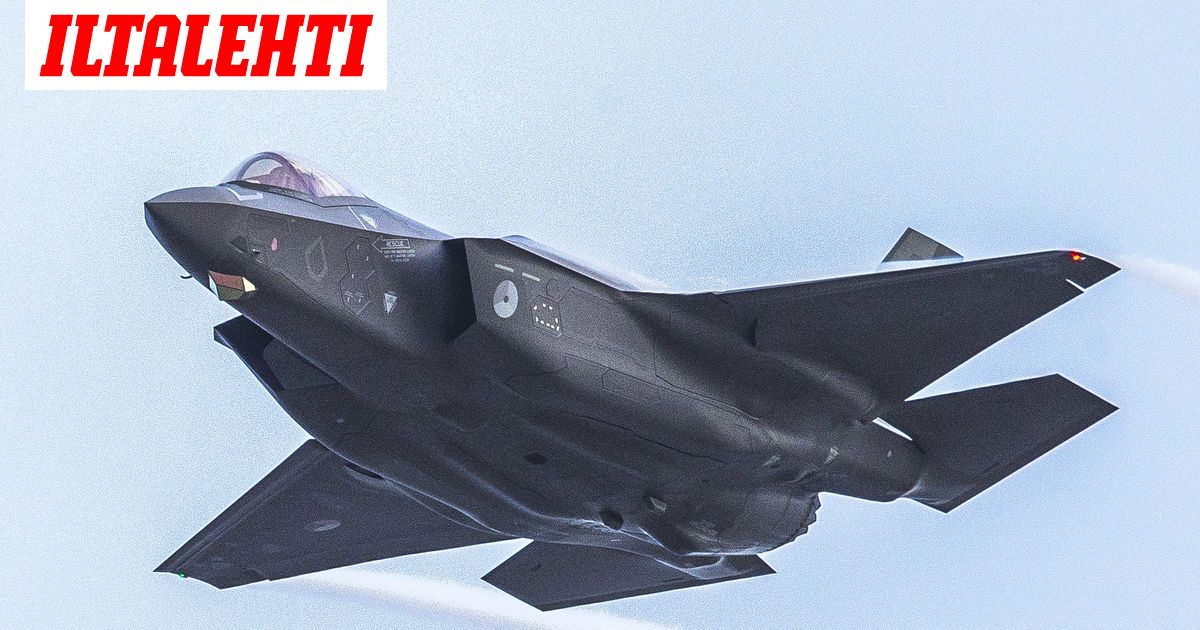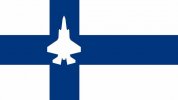Install the app
How to install the app on iOS
Follow along with the video below to see how to install our site as a web app on your home screen.
Note: This feature may not be available in some browsers.
You are using an out of date browser. It may not display this or other websites correctly.
You should upgrade or use an alternative browser.
You should upgrade or use an alternative browser.
F-35 Lightning II
- Viestiketjun aloittaja Hejsan
- Aloitus PVM

Yhden F-35:n hinnaksi 73 miljoonaa euroa – valmistaja kertoo alentaneensa hintaa ”radikaalisti”
Valmistajan mukaan ylläpitokustannukset mahtuvat ”helposti” Suomen budjettiin.
Itse tarjouskilpailun prosessia Lockheed Martinin edustajat kuvailivat ”uniikiksi”. Prosessi kesti useiden vuosien ajan ja oli yrityksen mukaan läpinäkyvä.
Prosessin aikana Lockheed Martin oli tekemisissä aina samojen henkilöiden kanssa Suomen päässä. Suomalaisista tuli prosessin edetessä eri yritysten tuotteiden ”asiantuntijoita”.
Prosessi ei sujunut täysin ilman erimielisyyksiä.
– Oli joitain jännittyneitä hetkiä, voin kertoa. Kuten suomalaiset ovat, he olivat hyvin suoria, he olivat erittäin asiallisia, mutta ilmoittivat meille, kun emme olleet vastaamassa odotuksia. (...) Saimme paljon erittäin positiivista palautetta, ja myös asioista, jotka vaativat työstämistä, Lockheed Martinin Suomen kampanjatiimi kertoi.
fulcrum
Greatest Leader
Intiassa isoin este taitaa olla 'Make in India' -vaatimus eli koneiden lisenssivalmistus, sama mikä muodostui kompastuskiveksi Rafalen kanssa.Ei näitä silti ihan sinne tänne vielä myydä, kaikki vientimaat ovat joko NATO-maita tai Yhdysvaltojen läheisiä kumppaneita. Intiaan myynti oli lähinnä huumoritasolla ja tälläkin hetkellä on Lähi-Idän kauppa jumissa kun mietitään miten konetta voidaan tehdä huonommaksi, jotta Israelin ilmaherruus ei ole kyseenalaistettu.
Nämä olivat lähinnä Intian aiheesta innokkaan lehdistön kuvitelmia, konetta ei missään vaiheessa tarjottu Intialle.Intiassa isoin este taitaa olla 'Make in India' -vaatimus eli koneiden lisenssivalmistus, sama mikä muodostui kompastuskiveksi Rafalen kanssa.
canada.Nyt kun on Sveitsi ja Suomi plakkarissa, niin mihin myydään seuraavaksi F-35?
No se tuli kuin kummelista. Edit - ja sillä välin tulikin,canada.
Viimeksi muokattu:

Britain planning to order second tranche of F-35 jets
The UK is currently undertaking "detailed analysis to evaluate the scale and timeline" for a purchase of a second tranche of F-35B Lightning aircraft.
 ukdefencejournal.org.uk
ukdefencejournal.org.uk
Osaatko kertoa miksi moisia tarvitset ja onko se tarve sellainen, että muiden kannattaa ne puolestasi etsiä? Tuntuu näet aika tarpeettomalta näin äkkiseltään tietää.Osaako joku äkkiseltään kertoa koneen moottorin painesuhteen, ohivirtaussuhteen ja ominaiskulutuksen perusmoottori/jp.?
Bypass ratio, (F135-PW-100, -400) 0.57
Mass flow (F135-100) 139.6 kg (307.8 lb)/s. OPR (F135-PW-100, -400) 35
Mass flow (F135-100) 139.6 kg (307.8 lb)/s. OPR (F135-PW-100, -400) 35
The JSF-F119 was the engine of the X-35 concept demonstrators, and because of the short time-scale it was in turn a direct derivative of the F-22's F119 engine.
In contrast, the F135 is optimised for the propulsion of the F-35, though it is likewise derived from the F119, and is thus a two-shaft low-BPR turbofan with an augmentor. On the basis of information released by 2005 the only significant difference between the two engines is that the F135 has a two-stage LP turbine (that of the F119 having a single stage). Whereas the F119 is loosely described as being "in the 35,000 lb (155.75 kN) class", and the JSF-F119 as being rated in the 170 kN (38,200 lb) class, the F135 is described as "in the 40,000 lb (178 kN) class." Indeed, it is likely that the F135 will eventually be developed to give power well beyond the figures given in the data below.
Apart from the broad outline given in the description below, because of its high security classification, little is publicly known of the actual hardware of the F135, apart from the overall opinion that, as the crucial blading is all fractionally larger, because of the greater mass flows, the engine should be exceptionally tough and durable. Pratt & Whitney has, however, been permitted to disclose some of the radical advances that this engine will introduce in the fields of self-diagnostics and health monitoring. Among technological "firsts" claimed for the basic F135 are on-wing (this simply means "with the engine installed in the aircraft") trim balancing, elimination of the need to rig the installation on replacing an engine, and the elimination of safety wire (previously used to ensure security of such items as nuts and bolts).
Ground-breaking PHM health-monitoring and self-diagnostics systems. The intention is that PHM, a new acronym which will become important (meaning Prognostics and Health-Monitoring), will automatically take account of any in-flight fault, or incipient fault, adjust engine operation and inform the pilot, and in real time transfer data to the aircraft's home base. Thus, any replacement components will be ready for retrofit as the aircraft lands, with the engine pronounced fit again (the plan is) in about 15 minutes, which is said to be a 94 per cent improvement over present times. Of course, that is based on the replacement of externals, not such items as turbine blades.
Externals, in fact, differ markedly from those of the F119 used in the twin-engined F/A-22, though accessories are grouped on the underside as in the ancestor engine. The F135 is expected to set a new low need for special maintenance tools, and to have every external item immediately available upon opening the large access doors with stealth-type zig-zag edges. Indeed, Pratt & Whitney says "all critical features" will be at once accessible. Objectives include a reduction in operating cost -- presumably compared with such engines as the F100-PW-229, for example -- of 50 per cent, and an extension in time between scheduled maintenance of 225 per cent (one F135 document even claims "Scheduled maintenance requirement eliminated"). To this end, PHM will make use of electrostatic and other sensors to monitor such parameters as debris generation, vibration, blade health and lubricating-oil quality. The suite of sensors will constantly monitor approximately 500 data streams, which will be integrated with the F-35's own systems. The complete PHM system has been developed in partnership with NASA Ames, which created vital data-fusion algorithms, NASA Dryden and NASA Glenn, with flight development to be carried out with a C-17. As noted previously, the aim is to predict the need for inspection or parts-replacement, so that, via a satellite link, the airbase or aircraft carrier knows the engine health before the aircraft returns from its mission.
Apart from the challenging 94 per cent improvement in fault-rectification time, other design objectives include a 35 per cent reduction in cost of ownership, compared to legacy systems, a reduction in fault-detection time despite a 50 per cent reduction in the number of maintenance technicians, three times the hot-section reliability, and a 225 per cent increase in time between shop visits.
Back in 1997 the JSF programme had firmed up into three major aircraft versions, conventional (CTOL), STOVL and carrier (CV). Today these are designated as:
F-35A Engine: F135-PW-100. This is the baseline version of the F135.
F-35B Engine: F135-PW-600. This engine differs from other versions in incorporating a vectoring nozzle, bleed-air ports for roll posts for lateral control at low airspeeds, and a forward drive shaft to the LiftFan to provide lift independently of the wings. The basic engine is identical to other versions.
F-35C Engine: F135-PW-400. This is almost identical to the F135-PW-100, apart from small changes in accessories, and elimination of materials not resistant to salty environments.
The following refers principally to the SDD engines:
Type: Two-shaft augmented turbofan, the F135-PW-600 version having additional STOVL features.
Intake: The intake hub is the same in all versions, being unaffected by connection of the LiftFan drive shaft.
Fan: Three integrally bladed rotors, derived from F119 but with new features giving greater mass flow with higher pressure ratio, improved stability, maximum resistance to bird and other impact damage, and minimum signature. Significantly lighter and less costly than predecessors, yet provides most of the thrust. The casing is the first to be made for the US military from organic-matrix composite (OMC) material. First-stage vanes (stators) hollow OMC, rotors 2 and 3 flank-milled titanium alloy. Split casing permitting reblading or minor repairs, and weld repairs are (mid-2004) being developed for all stages. Inside the nosecone a single bolt permits removal of the fan module in 40 minutes. This bolt is replaced in the Dash-600 engine by a connector to the LiftFan drive shaft. Inlet diameter 1,168 mm (46.0 in). Bypass ratio, (F135-PW-100, -400) 0.57; (F135-PW-600), conventional flight 0.56, powered lift 0.514.
HP Compressor: Six-stage SDD compressor derived from F119, rotating in opposition to LP spool. Split forward case in titanium alloy housing two stages of asymmetric variable-incidence guide vanes (stators). Cast nickel-alloy rear stators grouped in segments in titanium-alloy ring casing of high creep strength. All stators integrally bladed, either flat-milled like the fan or high-speed milled. All six rotors integrally bladed, first two in damage-tolerant titanium alloy, the remainder high-strength nickel alloy. Crucial No 3 bearing is a simple squirrel-cage unit, lighter and easier to install than the corresponding bearing in the F119 (which comprises a ring and 24 rods). The production bearing may be made of corrosion-resistant silicon nitride hybrid ceramic. Mass flow (F135-100) 139.6 kg (307.8 lb)/s. OPR (F135-PW-100, -400) 35, (F135-PW-600) conventional flight 34, powered lift 29.
Combustion Chamber: Short annular diffuser/combustor, derived from F119. Outer casing including HPT nozzle ring (lighter and less costly than in previous P&W fighter engines), handling airflow at 4,150 kPa (600 lb/sq in) at 649°C (1,200°F), and containing air-conditioning connections and inspection ports. Liner with impingement and film cooling containing Floatwall ceramic-coated nickel-based cast segments, each containing "thousands of holes", which "float" from their anchored location. Intense combustion with fuel/air ratio 20 per cent higher than in F100 engine to give near-record gas temperature exceeding 2,200°C (4,000°F).
HP Turbine: High-work single stage based on F119, with advanced airfoil coating and cooling derived from F119, but with cooling airflow doubled. Impingement cooling augmented by closing down rear stator angles. Nozzle ring organic-matrix vanes. The rotor comprises a main disk, miniature disk and cover plates, all incorporating the same high-strength powder-metallurgy (sintered) high-rotor blades of second-generation single-crystal Ni-based alloy, with advanced outer air seals. The HPT rotates at speeds exceeding 15,000 rpm, generating 47,725 kW (64,000 shp) from gas at just over 1,649°C (3,000°F), cooled by air supplied at 538°C (1,000°F) from the HPC. To minimise pressure loss the rotor blades are cooled by Tangential On-Board Injection (TOBI), each blade being a complex casting with multiple cooling passages. Growth in blade-tip diameter is controlled by a unique slow-responding thermally isolated support ring in materials selected for their low thermal expansion, giving passive clearance control through the normal engine-operating range.
LP Turbine: Two-stage design giving significantly greater shaft power than the single-stage LPT of the F119. Rotates in opposition to the HP turbine. Typical of the simplified design of the F135 are the main shaft bearings, (see note under HP compressor), and it is possible that the full production F135 may have a corrosion-resistant ceramic (silicon nitride) bearing. In the F135-PW-600 the LPT torque is transmitted through the fan and a dry-plate clutch to the LiftFan drive shaft, the turbine power being shared by the two driven items. Casing fabricated in refractory nickel and Pratt & Whitney proprietary materials. Supports aft-bearing compartment, whilst diffusing and turning the 1,093°C (2,000°F) efflux with minimum pressure loss (see next).
Afterburner: Large-volume with advanced flame-holder system. Fully variable convergent/divergent nozzle, with 15 hydraulically driven hinged flaps, controlling propulsive jet at 621 kPa (90 lb/sq in) at up to 1,927°C (3,500°F). Unique pressure-balance system to assist the hydraulic actuators which vary area and profile, and also to assist bypass air to reduce area when maximum loads are encountered. In the F135-PW-600 the complete nozzle can vector through 95° in 2.5 seconds to give 80.34 kN (18,000 lb st) lift force for STOVL. The Dash-100 and -400 LO axi-symmetric nozzle; The Dash-600 3BSM (three-bearing swivel module) has shorter variable flaps. It was designed to be able to bolt directly on to the STOVL version of the rival F136-GE-600 engine.
Accessories: Accessory gearbox driven off main HP shaft. Integrated Power Package (IPP) comprises the engine-start system and the F-35's Auxiliary Power Unit (APU). Dual fixed-displacement vane-type fuel pumps (the gear-type originally used added too much heat), with servo valves. Fuel/oil heat exchanger. Advanced prognostic and on-condition health-management systems. Commercially developed fire containment system.
Tässä vielä taustaa miten F135 päädyttiin:
SASC Chairman: Never was a JSF Engine Competition
Posted by Michael Bruno at 6/28/2010
"The Defense Writers Group had breakfast with Sen. Carl Levin (D-Mich.), chairman of the Senate Armed Services Committee, this morning, and the senior senator was uncharacteristically lively in his assertion that the Defense Department never had a competition for the F-35's powerhouse. "I'm sure of it," Levin told reporters abruptly, causing a few of us to snap our faces up from our plates of eggs and bacon. To help prove it, he and his aides later emailed reporters the following chronology put together by the SASC's majority staff:
Has there been a competition between the Pratt & Whitney F135 and the GE/Roll Royce F136?
No. There has never been an engine competition for the Joint Strike Fighter.
In 1996, DOD awarded competitive contracts to the airframe competitors for the JSF program, Boeing and Lockheed Martin for the concept development phase of the JSF program.
· Both contractors selected a variant of the Pratt &Whitney F119 engine (the F-22 engine) as their propulsion system.
· DOD picked a single contractor (Lockheed Martin) for the JSF engineering and manufacturing development (EMD) phase in 2001.
· Lockheed Martin maintained their selection of the P&W engine when they were awarded the EMD/systems development and demonstration (SDD) contract in 2001.
· John Roth, and official in the DOD Comptroller’s office, acknowledged that no competition was ever held in testimony before the House Oversight and Government Reform, Subcommittee on National Security and Foreign Affairs hearing on May 19, 2010.
· When the JSF was first conceived, it was assumed the F-22 engine (produced by P&W) would be used in the JSF.
· Citing commonality with the F-22, DOD directed the competing air vehicle contractors to use the Pratt & Whitney engine as the engine for the concept demonstration contract.
· It later became clear the F-22 engine (F119) would not meet requirements for the JSF, but no competition was ever held to meet the JSF requirement.
· The government paid Pratt & Whitney to develop a derivative of the F119 engine to meet the JSF requirement.
· That new Pratt & Whitney engine, called the F135, is now the primary JSF engine
J0h1F
Respected Leader
Tavanomaisen fissioon perustuvan plutoniumpommin miniatyrisointikaan ei ole niin vaikeaa kuin on sen tekeminen säädettävätehoiseksi (kuten USA:n nykyiset) tai etenkään kolmivaihepommin (fissio-fuusio-fissio) tekeminen siten.Perinteisen Hiroshimapommin tasoisen laitteen teknologisissa ratkaisuissa juu, mutta kun aletaan puhumaan moderneista ydinkärjistä joissa mm. miniatyrisointi on kehitetty niin pitkälle kuin mahdollista, niin niiden salaisuudet on äärettömän tarkasti varjeltu. Sellaisia ei Iran/Pohjois-Korea/Jne. tason tekijät pysty valmistamaan.
Ja uraanipomminkin miniatyrisointi onnistuu aina 203 mm tykin kranaattiin saakka (ja sitä myöten tavanomaisen kokoisiin lentopommeihin myös), se tosin vaatii hyvät laskelmat.
Olympiakasarmi
Kenraali

Näin F-35-hävittäjää on käytetty taistelussa – ”Koneella on uskomattomia toimintakykyjä”
Suomen seuraava hävittäjä, Lockheed Martinin F-35A ”Lightning II” on niin uusi kone, että sitä on käytetty todellisissa taistelutoimissa vain noin 3,5 vuoden ajan.
Mielenkiintoista seurata tuleeko Suomen hävittäjiin meidän omia siihen integroituja järjestelmiä - onko tarvetta, kykyä ja mahdollista. Itse ylläpitoon ja logistiikkaan varmasti kehitetään omat versiomme mutta poissuljettua ei ole sekään, että koneen tiedustelu, viestintä tai taistelukykyynkin voisi jotakin kehittyä. Tämä ajatus näin Israelin tekemisistä johdettuna, olkoonkin että he erityisasemassa saivat oletettavasti hieman isommat valtuudet järjestelmien koodeihin.
Näin F-35-hävittäjää on käytetty taistelussa – ”Koneella on uskomattomia toimintakykyjä”
Suomen seuraava hävittäjä, Lockheed Martinin F-35A ”Lightning II” on niin uusi kone, että sitä on käytetty todellisissa taistelutoimissa vain noin 3,5 vuoden ajan.www.is.fi
Jenkit tuli tarjouksessaan niin paljon vastaan, että en ihmettelisi jos jotain avauksia tälläkin saralla olisi.
Linkitys tulenjohtoon on ollut jo tamperelaista käsialaa ja F-35:n kyvykkyys laajentaa tätä osa-aluetta moninkertaisesti (mm MADL) - jopa täysin muuttaa konseptia. White paper laajenee kaikkiin - maa- ja merivoimiin, tulenosoitukseen, tiedusteluun jne.
Miten F-35 tutkan kriittinen informaatio esimerkiksi jalkautuu metsään yksittäisen ryhmänjohtajan näytölle.

Hävittäjähankinta tuo Pirkanmaalle lisätyöpaikkoja ja uusia mahdollisuuksia – näin Patria ja Insta Group kommentoivat
Hävittäjähankinnan myötä Patrian Pirkanmaan toimipisteelle tulee uusia työpaikkoja. Nokian Linnavuoreen työpaikkoja tulee 30–40 ja lisäksi Jämsän Halliin noin 80. Tamperelainen teknologiayhtiö Insta Group näkee hävittäjähankinnan merkittävänä mahdollisuutena.
Viimeksi muokattu:



